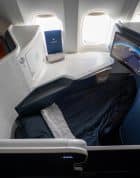There can be seemingly endless challenges and obstacles that lie between applying for your first credit card and stepping into that glamorous business class cabin for the first time. But thankfully, there’s no need to fly solo: here’s a collection of 7 websites and online resources that I use on a regular basis to help me stay on top of my points balances, plan upcoming trips, and discover new award redemption possibilities.
In This Post
- 1. AwardWallet
- 2. FlightConnections
- 3. Great Circle Mapper
- 4. Routes Online
- 5. ExpertFlyer
- 6. Award.Flights
- 7. FlightMemory
- Conclusion
1. AwardWallet
Staying organized is paramount during the earning phase, and in addition to using spreadsheets to track the various credit cards you open and close, you can also use AwardWallet to track your points balances across all the major frequent flyer and credit card points programs.

AwardWallet works by securely storing your login credentials to every loyalty program and checking each account periodically to see if the points balance has changed.
I know many people might be hesitant to hand over their login details to a third-party app, but AwardWallet assures its users that its encryption technologies follow the industry standard, and I can safely say that neither I nor anyone I know has ever faced any security issues through using AwardWallet.

In addition to giving you an easy instant view of your points balances across many programs (including functionality to track points balances for multiple players), AwardWallet’s interface also keeps track of your points expiration deadlines, and will send you email alerts if any of your points are about to vanish into thin air.
Furthermore, AwardWallet can track additional perks and benefits in your account such as companion fares or upgrade vouchers, and will ping you if any of those are coming up for expiry as well.

I personally have used AwardWallet in the past, although in recent years I’ve preferred to keep track of my points balances on my own. Nevertheless, it’s a service that’s widely used by many Miles & Points practitioners, so give it a try if you think you might need some help staying organized.
The free version is already jam-packed with features, but if you’d like to try out additional capabilities such as historical charts for your points balances, then the paid version will cost you US$30 per year.
2. FlightConnections
While earning the points is pretty simple as long as you’re able to manage everything, the redemption side of the game is often likened to more of an art than a science, and there are a variety of tools and websites I use in coming up with ideas for my trips, planning my routes, and searching for availability.
Let’s go through them one by one, starting with FlightConnections, an interactive map service that can help you answer, at a glance, the question of which airlines fly where.
I’ve covered the usage of FlightConnections in this video, which should be essential viewing material for anyone looking to get the hang of planning award trips:
Essentially, in order to effectively search for award space for a trip you have in mind, you have to know which routes to search using the search engines (such as Aeroplan.com, United.com, or the ExpertFlyer search engine which we’ll discuss below).
FlightConnections solves that problem by allowing you to choose any airport around the world and showing you which airlines fly in and out of that airport.

You can then filter the list by alliance and individual airline as well. For example, in planning an Aeroplan Mini-RTW trip to Asia, you may well want to find out which Star Alliance routes you could take departing from Tokyo Haneda.
Simply select Tokyo Haneda on FlightConnections and filter for Star Alliance airlines:

The free version of FlightConnections is already extremely useful for your trip-planning needs. However, the premium version, at a modest cost of €0.99 per month, offers even more helpful features, such as the ability to filter by more than one airline at once (so you could filter out all the Star Alliance airlines that have hefty fuel surcharges on Aeroplan redemptions, for example).
Even if you aren’t planning an award trip, you’d probably have lots of fun playing around with FlightConnections to see which routes are currently being operated by the world’s airlines and getting a bit of travel inspiration from that.
3. Great Circle Mapper
I’m often asked how I make all the route maps you see on Prince of Travel, and the answer is the Great Circle Mapper, or GCMap.
This is a service I can’t live without, as it allows me to plot my routing on a map and look at what the total distance would be, which is crucial knowledge when my potential routing is at the boundary of Aeroplan’s maximum permitted mileage (MPM) or when I’m planning a redemption using a distance-based award chart like British Airways Avios or the ANA Round-the-World Award.
GCMap is easy and intuitive to use. Simply plug in your routing using IATA airport codes (as in “YYZ-LAX-TPE-HKG-SIN-PER”) in the search engine and you’ll be presented with the map output.

The “Map Style” options underneath the map allow you to toggle between various styles, while the “Distances” section provides information on the exact Great Circle distance flown.
Keep in mind that these distances may not be an exact match to the distances used by various frequent flyer programs, but they should generally be accurate to within about 10 miles of each other.

Then the “Map Controls” section at the bottom provides you with more opportunities to style the map to your liking, such as choosing the specific map projection (the Polar map is one of my favourites, as long as travel takes place entirely in the Northern or Southern Hemispheres), the text to be displayed next to each point (you can choose from the airport name, city name, or both), and the colour and style of specific lines or dots.

Bottom line? Any time you need to think about flight distances or look at your proposed routing on a map, the Great Circle Mapper should be your go-to resource.
4. Routes Online
Routes Online is an incredibly comprehensive website for keeping track of route announcements, route changes, aircraft updates, and general airline scheduling updates. As someone who’s always looking for cool new routes to fly, I check in with Routes Online frequently to understand the major movements in global aviation that might affect my future trips.
At first glance, staying on top of airline route developments might appear to be something that only hardcore aviation geeks would be interested in, but it can in fact give you a major leg up when planning trips.

For example, when planning my Bali trip for Christmas of 2017, I had failed to book my preferred routing on EVA Air business class of Toronto–Taipei–Bali when the space was released at T-330 days, meaning that all the award availability had been snapped up by the time I went to book.
However, around February of 2017, I saw on Routes Online that EVA Air would be increasing their Toronto flights from five-times-weekly to daily, meaning that two additional flights per week would soon be loaded into the inventory.
Lo and behold, I was able to snag two seats on the EVA Air business class flight on December 23 as soon as they were released, which would’ve otherwise been a pipe dream if I hadn’t been paying attention. As a result, I was able to book one of the most direct routings on the long, long journey down to Bali, which gave us ample time on the ground to enjoy our Christmas getaway.

Routes Online is also an important resource for keeping track of aircraft changes. For example, when EgyptAir first acquired their new Boeing 787 Dreamliners, they had announced that they would be putting them on their Toronto route as of October 2019; however, a few months ago they changed their minds and decided to cut the 787 from Toronto and move it onto their Tokyo route instead.
If any of you had booked EgyptAir’s 787 specifically for their lie-flat business class seats, you might wish to contact your ticket issuer and ask to change your flight (there’s no guarantee that you can get a free change as a result of aircraft equipment swaps, but it gives you some leverage when talking to the agent).
The more you fly, the more I’d recommend that you keep up with Routes Online as an important resource when booking and managing your upcoming travels.
5. ExpertFlyer
ExpertFlyer is the ultimate resource for frequent flyers, offering a suite of powerful tools to help guide you through the at times byzantine world of global commercial aviation. I’ve written a detailed walkthrough on using ExpertFlyer’s many features in the past, but in this section I’ll briefly summarize the tools that I use the most often.
At the top of that list is no doubt the Awards & Upgrades section, which allows you to search for award flights on most of the world’s major airlines in any class of service.

Compared to your average airline search engine, ExpertFlyer allows you to specify an entire week of dates to search at once; however, the downside is that it can only search a single for space on a single airline at once, so it’s best used in conjunction with a different search engine in separate tabs. Refer back to the YouTube video I included above for a live-action demonstration.
Another huge benefit of ExpertFlyer is the ability to set Flight Alerts, which will notify you via email should additional space on your desired flight become available. This saves you from the trouble of having to check back yourself on a regular basis, and has easily resulted in hundreds of dollars in value for me by alerting me to the award space I need in a timely manner.

The Flight Availability section allows you to check the flight loads of any scheduled flight, which can be very helpful in looking for flights that have multiple unsold business class seats and are therefore likely to release last-minute award space, or searching for alternative flights to get rebooked when your travel plans are wrecked by IRROPs.
I also regularly use the Seat Map functionality to help me select seats for upcoming flights, as well as the Travel Information section, where I can look up minimum connection times, interline agreements, and more.
ExpertFlyer is a paid service which costs US$100 for the year, but like I said, I’ve easily recouped that value multiple times over as a frequent flyer. Try it out using the five-day free trial, and if you like what you see and would like to benefit from setting some Flight Alerts, then I’d highly recommend getting a membership.
6. Award.Flights
While I don’t personally use it very often, Award.Flights is another tool that’s used by many people who regularly book award trips. Award.Flights is set up as a Chrome extension that logs in to various frequent flyer programs on your behalf and automatically conducts searches in the background.
You’ll need to set up the Award.Flights extension with your login info beforehand, and then you can specify the exact searches you want to run and let it do its work. The resultant output will show you what your selected frequent flyer program’s search engine has spit out on the dates and routes you’re looking for.

Since Award.Flights essentially replicates the results of existing search engines, it’s also subject to the limitations of those search engines.
For example, if you search Toronto–Lisbon on the Aeroplan search engine, Award.Flights may spit out a bunch of results on Air Canada even though alternative routings exist, because that’s what the Aeroplan search engine itself is liable to do.

My personal preference when hunting down award space to is use the Aeroplan search engine and ExpertFlyer side-by-side, so I don’t use Award.Flights too often, but it’s a good way to automate your searches in the background if you’d rather not deal with Aeroplan’s clunky search engine directly.
7. FlightMemory
Finally, after I’ve planned, booked, and taken the flights for a trip, I like to keep them well-documented in a little personal collection of mine. For that, I use FlightMemory, which allows me to track all the flights I’ve taken since I began keeping records in 2013.

FlightMemory allows you to input the details of every flight you’ve taken, including the airline, flight number, duration, departure and arrival times, class of service, seat position, and aircraft type.
You can choose to record as many or as few of these details as you’d like – I personally choose to take note of the class of service of all my flights, but can’t really be bothered to keep track of window and aisle seats or whether I flew on an A320 or an A321.
Then you’re able to generate maps of your flying behaviour and look at statistics on your most-flown airlines and routes and most frequently visited airports, and you’re able to narrow down the maps and statistics by year as well.
Logging my travels on FlightMemory is one of the first things I do once I get back from a trip, since I know I’ll get so much satisfaction from looking back on all these flights in many years’ time.

Conclusion
From the initial stage of accumulating points, to the route research and trip planning, to the at times gruelling search for award availability, and finally to the post-trip reflection phase, there are a variety of online resources that can make your life easier as you earn and burn.
Besides these seven websites, which have served me very well over the years, what other ones am I missing? Feel free to share your own favourite resources with me in the comments.





















Hey Ricky, I’m one of those that relied on the fact that the 787 Dreamliner would be replacing the old Egyptair product from Toronto to Cairo. I booked a mini-RTW for next July already. Is the change that you referenced in this article only applicable to this winter season and there is still a chance the 787 will be used for Toronto-Cairo next summer? I would suggest you update T.J.’s guest blog as it will mislead readers like myself, especially as the cancellation of Egyptair’s plans came out before T.J.’s post, which shows a lack of diligence.
I made a similar mistake and booked YYZ to CAI expecting to be on a 787 because of something I read in one of your posts. Thankfully I caught it within 24 hours and was able to find alternate availability.
I’m surprised you omitted KVS Availability Tool. Mac users sometimes ignore it, because it must run in a Windows session, which makes Mac users feel tainted and icky. But it’s unparalleled in its offering and in the care and thoroughness its developers devote to its care and feeding. The full version costs USD$75/year and when I compared it to its nearest competitor Award.flights, it wins hands down, IMHO. I’d strongly counsel readers to have a look at it and make your own assessment. I simply can’t live without it. Combined with Expertflyer and Awardwallet I feel I can survive what this game throws at me.
Thanks, Ricky for this piece. Very useful for newbs, of course, but learning about Routes Online was great for me!
Do you need to pay to use Awardwallet?
I feel it’s worth the 30.00. The enhanced features are quite nice
There’s a free version that’s enough for most people’s needs. If you’d like to pay US$30 per year for some additional features and to support AwardWallet then you’re free to do so as well.
Nice one on FlightMemory. Been wanting to input my flights to create a map in awhile, so this is perfect timing. Thanks!
It’s so satisfying to look back on every now and then. I highly recommend starting your record-keeping as early as possible.
I’ve been going through my emails to fill in as many flights as I can to get a nice picture of all the stats available. Very satisfying indeed.
Isn’t it? My great regret is that I’m unable to track down all the flights I took in my childhood to get an accurate lifetime picture.